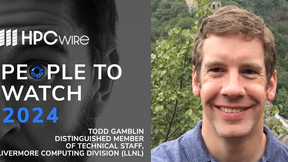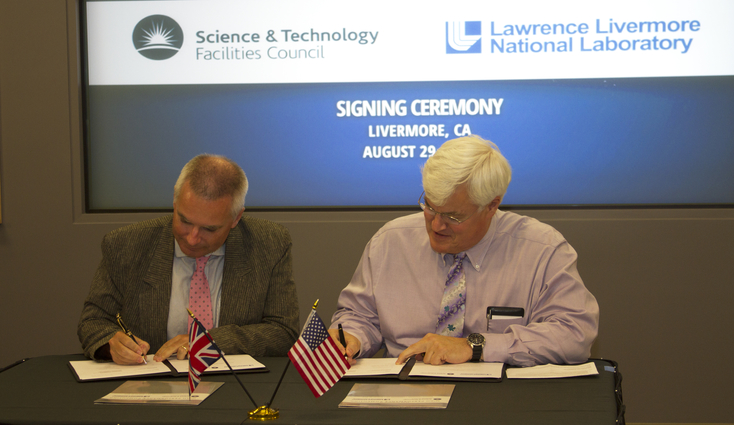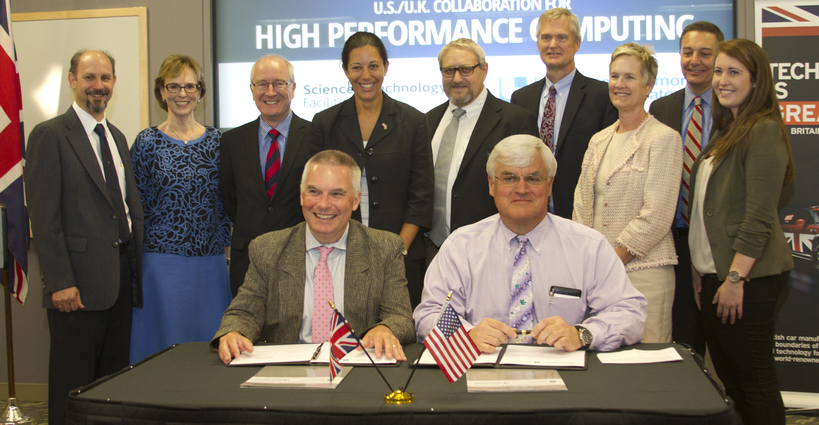Lawrence Livermore and the U.K.'S Science and Technology Facilities Council agree to collaborate in boosting economic competitiveness through HPC
Lawrence Livermore (LLNL) Director Parney Albright and Chief Executive John Womersley of the United Kingdom's STFC signed a memorandum of understanding (MOU) at a ceremony in Livermore's high performance computing (HPC) center that provides a vehicle for technical and business development exchanges between the HPCIC and the STFC's Hartree Centre (HC), which is dedicated to making HPC more accessible to British industry and academia.
"This agreement builds on the strong and enduring alliance between our countries in matters of security and economic cooperation," said Bruce Held, National Nuclear Security Administration (NNSA) acting administrator. "The common goals we share and complementary strengths we bring to this collaboration will allow our HPC Innovation Center and Daresbury's Hartree Centre to exploit their clear synergies to our mutual benefit."
David Willetts, UK Minister for Universities and Science said, "The partnership between the Hartree Centre and Lawrence Livermore National Laboratory's High Performance Computing Innovation Centre is a significant development. It will greatly speed up the innovation of products and services to help us address complex challenges such as climate prediction and disease detection. This is a huge step forward in the big data revolution, one of the eight great technologies which will propel the UK to future growth. It will increase the capability of both centres, allowing them to harness the power of high performance computing."
Attending the ceremony were U.K. Consul General Priya Guha and John Bancroft, head of project development in the STFC's Asia Pacific region, as well as LLNL Deputy Director Bill Goldstein and HPC Innovation Center Director Fred Streitz.
Areas of collaboration are to include the development and operation of HPC technologies and applications and associated industrial outreach and partnership efforts. The HPCIC and HC were created to spur economic development by increasing the impact of HPC on technological innovation. As a result of this common mission the HPCIC and HC share common goals: making HPC resources and expertise available to industry and academia; seeking to develop and deploy scalable solutions that solve customer problems; proving a return on investment to an often skeptical audience; and a focus on accelerating the innovations that spur economic growth.
In addition, both centers offer an IBM Blue Gene/Q supercomputer as their primary industrial computing resource. Among the Livermore supercomputing resources available to the HPCIC for collaborative work is "Vulcan," a five-petaflop/s (five quadrillion floating operation per second) IBM Blue Gene/Q (BG/Q) system that is ranked No. 8 on the industry standard Top500 list of the world's fastest supercomputers. Daresbury's HC is home to the UK's most powerful supercomputer, a 1.4-petaflops BG/Q system. The availability of a common architecture will facilitate the joint development of HPC applications and ancillary software.
LLNL opened the HPCIC in June 2011 as a way to make supercomputing resources and expertise available to industry for technological and business innovation, with the ultimate goal of boosting the nation's economic competitiveness. By so doing, the HPCIC also aims to accelerate the advancement of U.S. science and technology and develop the HPC-skilled workforce of the future. The HPCIC was the first facility opened in LLNL's Livermore Valley Open Campus, an area designed to facilitate collaboration with industry and academia in a broad range of disciplines.
The Hartree Centre was created in April 2012 as part of the UK's "e-infrastructure initiative" to broaden and deepen the use of HPC in industry and academia, particularly in organizations with little experience in supercomputing. The objective is to generate positive economic impact from the HC's activities.
Industry's adoption of high-end supercomputing has been hindered by one or more barriers, such as the high cost of HPC systems; the lack of software appropriate to the task; or a lack of domain expertise in applying HPC to industrial problems. Both the HC and HPCIC are designed to remove these hurdles, to demonstrate the potential of supercomputing and to accelerate innovation for economic development.
Initial joint projects with HC will likely include the development of software tools that would allow industry to leverage BG/Q's computing power for industrial and business applications. BG/Q's architecture lends itself to data intensive computing tasks important to work in applications such as cybersecurity, network optimization, atmospheric modeling, bioinformatics and medicine. Data intensive computing is commonly referred to as "big data."
The STFC keeps the UK at the forefront of international science and tackles some of the most significant challenges facing society. The Council has a broad science portfolio and works with the academic and industrial communities to share its expertise in materials science, space and ground-based astronomy technologies, laser science, microelectronics, wafer scale manufacturing, particle and nuclear physics, alternative energy production, radio communications and radar. It also operates or hosts world class experimental facilities including the ISIS pulsed neutron source, the Central Laser Facility, and is also the majority shareholder in Diamond Light Source Ltd. Internationally STFC enables UK researchers to access leading international science facilities by funding membership of international bodies including the European Laboratory for Particle Physics (CERN) and the European Southern Observatory.
Contact
Donald B Johnston[email protected]
925-423-4902
Related Links
Hartree CentreSci-Tech Daresbury
Daresbury Laboratory
HPCIC
LLNL Computation
Advanced Simulation and Computing (ASC) Program
LLNL
Tags
HPC, Simulation, and Data ScienceHPC
Computing
HPC Innovation Center
Featured Articles










